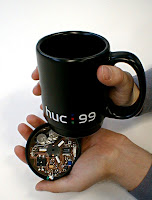Currently we have an assignment in our Pervasive Computing class that asks students to design and develop a system where actions are associated with artifacts. Technically students should develop a web based solution using RFID. Apropos RFID, … if you look for a good introduction on RFID read Roy Want’s IEEE Pervasive Magazin paper [1].
 We use the hardware from http://nabaztag.com/ (Ztamp:s and Mir:ror) as the focus is on the concept and application and not on the underlying technology. To ease development Florian and Ali have developed a little system that offers WebCallBacks (students can register a URL and that is called when a tag is read).
We use the hardware from http://nabaztag.com/ (Ztamp:s and Mir:ror) as the focus is on the concept and application and not on the underlying technology. To ease development Florian and Ali have developed a little system that offers WebCallBacks (students can register a URL and that is called when a tag is read).
Linking by tagging of objects has been well explored, e.g. [2] and [3], and I think it is about time that this technologies will make an impact in the consumer market – the technology gets cheap enough now (and perhaps one of our students has a great idea).
 Some years back (in the last millennium) a company tried to push linking of paper adverts and digital content with the CueCat (http://en.wikipedia.org/wiki/CueCat) – I was impressed and inspired at that time but in my view it had two major weaknesses: (1) technically too early and (2) encoding of serial numbers instead of URLs. The RadioShack catalog and the Wired Magazine that included codes showed the potential – but it was too cumbersome as it was restricted to the PC …
Some years back (in the last millennium) a company tried to push linking of paper adverts and digital content with the CueCat (http://en.wikipedia.org/wiki/CueCat) – I was impressed and inspired at that time but in my view it had two major weaknesses: (1) technically too early and (2) encoding of serial numbers instead of URLs. The RadioShack catalog and the Wired Magazine that included codes showed the potential – but it was too cumbersome as it was restricted to the PC …
We did some work on the topic, too around that time – at RFID reader integrated in a glove – which resulted in a Poster at ISWC [4] and a patent [5].
[1] Want, R. 2006. An Introduction to RFID Technology. IEEE Pervasive Computing 5, 1 (Jan. 2006), 25. DOI= http://dx.doi.org/10.1109/MPRV.2006.2
[2] Harrison, B. L., Fishkin, K. P., Gujar, A., Portnov, D., and Want, R. 1999. Bridging physical and virtual worlds with tagged documents, objects and locations. In CHI ’99 Extended Abstracts on Human Factors in Computing Systems (Pittsburgh, Pennsylvania, May 15 – 20, 1999). CHI ’99. ACM, New York, NY, 29-30. DOI= http://doi.acm.org/10.1145/632716.632738
[3] Ljungstrand, P. and Holmquist, L. E. 1999. WebStickers: using physical objects as WWW bookmarks. In CHI ’99 Extended Abstracts on Human Factors in Computing Systems (Pittsburgh, Pennsylvania, May 15 – 20, 1999). CHI ’99. ACM, New York, NY, 332-333. DOI= http://doi.acm.org/10.1145/632716.632916
[4] Schmidt, A., Gellersen, H., and Merz, C. 2000. Enabling Implicit Human Computer Interaction: A Wearable RFID-Tag Reader. In Proceedings of the 4th IEEE international Symposium on Wearable Computers (October 18 – 21, 2000). ISWC. IEEE Computer Society, Washington, DC, 193. (Poster as large PNG)
[5] US Patent 6614351 – Computerized system for automatically monitoring processing of objects. September 2, 2003. http://www.patentstorm.us/patents/6614351/description.html
 The paper discusses the linking of digital resources to the real world. We investigated how to augment everyday objects with RFID and Near Field Communication (NFC) tags to enable simpler ways for users to interact with service. We aim at creating a digital identities of real world objects and by this integrating them into the Internet of Things and associating them with digital information and services. In our experiments we explore how these objects can facilitate access to digital resources and support interaction with them-for example, through mobile devices that feature technologies for discovering, capturing, and using information from tagged objects. See [1] for the full article.
The paper discusses the linking of digital resources to the real world. We investigated how to augment everyday objects with RFID and Near Field Communication (NFC) tags to enable simpler ways for users to interact with service. We aim at creating a digital identities of real world objects and by this integrating them into the Internet of Things and associating them with digital information and services. In our experiments we explore how these objects can facilitate access to digital resources and support interaction with them-for example, through mobile devices that feature technologies for discovering, capturing, and using information from tagged objects. See [1] for the full article.




